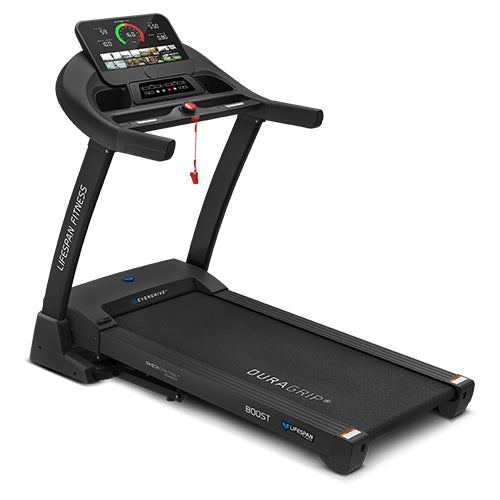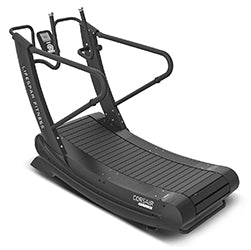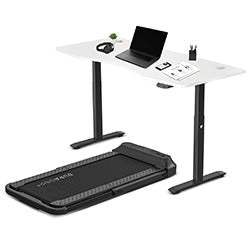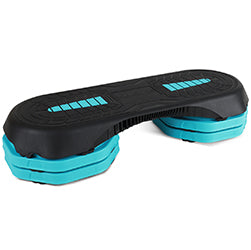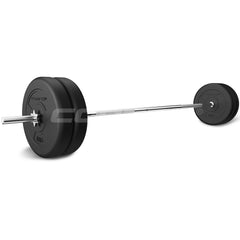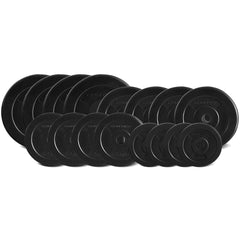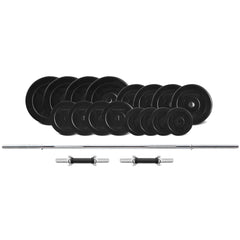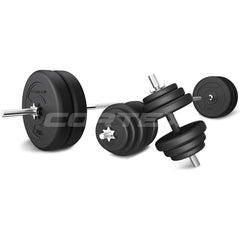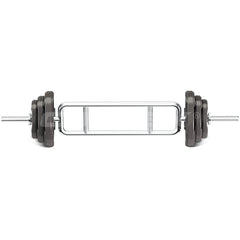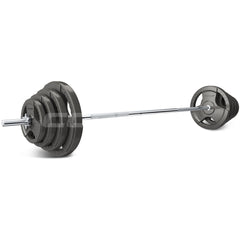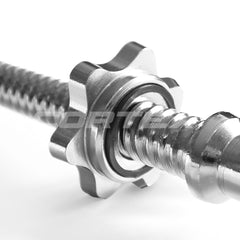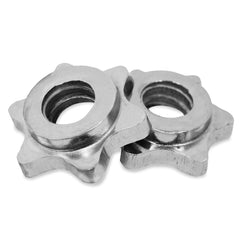Standard Weights & Bars
While you may think that a set of weight plates is the domain of serious weight lifters and hardcore body builders, a weight plate set is actually an impressively diverse piece of equipment, and has high adaptability to different training modalities and fitness goals. Weight plates have tremendous benefits for both advanced trainers and those just starting out, so don’t be frightened away by their intimidating appearance and variety. Almost everyone can benefit from a weighted plate in their fitness arsenal. Our CORTEX range of standard weight plates include choices for almost every type of user, including cheap weight plates, and different materials such as cast-iron weight plates, steel weight plates, as well as the choice of an Endurashell PVC coating for extra durability. All of our standard plates have standardised sizes to suit 25mm bars. On top of a solid selection of plates to choose from, Lifespan Fitness also has many options for weight plate storage such as a weight plate rack to keep your weights in good condition, making weight changes easier and keeping your workout space safe.
CORTEX’s range of cast-iron weight plates come in a variety of weights to suit your own fitness level and exercise regime. In the lower range you can find weights as low as 1.25kg and 2.5kg, and going up through the range there are 10kg weight plates, 15 kilo iron weight plates, up to 20kg weight plates. It’s possible to purchase these individually, or in handy weight plate sets to make sure you’ve got the full range of weight for an optimal workout. We also offer packages inclusive of weight plate racks, as well as different types of bars and accessories.
There are a few things to look for when evaluating material for your weight plates. Choosing high quality materials in your weight plates will allow you to focus on your workout, and mean you can rely on your equipment for a longer period of time. Certain metals such as steel are susceptible to rust if not built with adequate protection, or if not cared for properly. Most CORTEX standard weight plates are made with heavy-duty cast iron, which are designed to be rust and chip free, and provide greater durability. CORTEX’s EnduraShell coating encases a PVC layer around a cement filling, protecting weight plates from damage and creating a longer lasting product. In terms of design, many of CORTEX’s plates will come with a lip (thicker edge) for easier gripping, and are suitable to use by themselves or attached to a bar. Other weight plates will have a Tri-Grip design with convenient handles built into them on the sides. This allows for easy handling when used as free weights, and is generally preferable for individual use.
If you’re planning on attaching your plates to a bar, there are a few options you can choose. You may also need to keep in mind the compatibility of the weight plate with the bar you’re using, as not all of them are the same. Standard weight plates will have a centre hole with a standard 25mm diameter, meaning that only bars with the same size will be able to fit your plates. Olympic bars, on the other hand, have a standardised 50mm diameter, meaning they can’t be used with standard plates, and vice versa for an Olympic weight plate on a standard bar. While it is technically possible to fit an Olympic weight plate onto a standard bar, as the Olympic hole will be bigger than the standard bar’s diameter, it’s not recommended as the weights will not be properly secured, making them unsafe to use. There are a few different types of standard bars you may want to use. There’s the standard 6ft barbell, which comes with a precise knurl grip handle that creates a firm yet non-abrasive hold. The knurling is also centred for greater grip during squats. Weight plates can be secured onto the barbells using star-shaped spiral lock collars, with a standard 25mm diameter to fit standard weight plates. They also have a strong chrome finish for extra durability. You may also be interested in a tricep bar, which is an oval shaped bar with two parallel hand placements that run down the middle. This is a great option for focused strength work on the biceps and triceps. Lastly, there’s the curl bar, which is slightly shorter with a cambered ‘W’ shape. This creates a comfortable ergonomic design that’s easier on the wrists, forearms and elbows. These are also a great option for an upper arm workout focusing on the triceps and biceps. CORTEX’s standard dumbbell handles also feature a chrome finish and spiral lock collars, and are built with a rubber handle for easy and comfortable gripping.
When it comes to weight storage, you might wonder why you can’t simply leave plates stacked on the ground and call it a day. In reality, getting yourself some dedicated weight storage will save you a tonne of space, make weight changes much easier, and will improve the safety of your fitness area. With a proper weight storage setup you won’t have to constantly wind through scattered weights across the floor. This will also prevent damage to your floor, especially if your training space is built with floorboards. You can choose between a weight plate tree, or a toaster rack plate holder. The CORTEX standard weight tree holds up to 200kg of weight and comes with a slot to store up to two standard barbells, while the toaster rack holds up to 500kg of weight and can also fit Olympic weight plates.
Weight plates have the great advantage of being highly adaptable to many different training modalities and provide a great number of benefits outside of just building and maintaining muscle. While you may want to attach your plates to a bar, using the plates as a free weight (without a bar) can also make for a great workout. For these exercises, you may want to use a Tri-Grip handle plate for a more comfortable experience and easier grip. For functional strength, exercise examples include a reverse lung, which will train your glutes and quads as well as working the abdominals and upper body. There’s also plank plate switches, which are a fantastic core exercise that improves stability and back muscles. You could also try a Halo, which involves swinging the plate around your head in a circular motion, which will train your shoulders, biceps, triceps, back and abs. If you’re looking to improve cardiovascular health, you can easily incorporate weight plates into a cardio exercise. Weight plates are often used in High Intensity Interval Training (HIIT) exercises, as they are efficient at elevating heart-rate and maximising intensity. For this type of training, you may want to use lighter weights such as 5kg weight plates or 10kg weight plates, while the 15kg to 20kg range can be used for focused movements and compound lifts. Some good exercises to try are overhead lunges or walking lunges.
Standard weight plates are a highly adaptable piece of equipment, and allow you to accelerate most workouts to achieve your fitness goals. It’s important to take into account your own level and what you want to achieve before purchasing a pair yourself, but rest assured there’s almost certainly a weight plate that suits your personal needs.
You can check out our guide on buying weight plates for your home gym here.
Standard Weights & Bars FAQ
Putting together a solid home-fitness setup is really only complete with a good set of weight plates. While they’re often added to a barbell or dumbbell bar, they also make great fitness tools in their own right. Many of our CORTEX cast-iron plates are built with a Tri-Grip design to allow for easy handling when used independently. Others will come with a lip (thicker edge) for easier gripping. Weight plates can be used by themselves, or added to a barbell or dumbbell bar, as well as plate-loaded weight machines.
Weight plates can serve a variety of functions but are generally beneficial for incorporating extra weight into an exercise for focused muscle growth, increased intensity and functional strength training. Great strength building exercises include lunges, squat presses, lateral raises or plate push ups. If cardio is more your jam, you may want to use something lighter, such as 5kg weight plates or 10kg weight plates, to incorporate into high intensity movement for that added burn. Standard weight plates are often used in High Intensity Interval Training (HIIT), which aims to increase your heart rate in as short a time as possible. Adding a weight to the mix is a fantastic way to accelerate the workout to the next level, and can deliver great results.
Standard weight plates are a highly adaptable piece of equipment, and allow you to accelerate most workouts to achieve your fitness goals. It’s important to take into account your own level and what you want to achieve before purchasing a pair yourself, as there are different types to suit different purposes.
You can check out our guide on buying weight plates for your home gym here.
You’ve probably never bothered to take your weights and whack them on a scale to see if they’re actually the weight they claim to be, so it's normal to wonder whether the plates you’re using are accurate or not. So, should you be concerned? Luckily, the majority of the time you can rest assured that the weight plates you buy will be the correct weight that’s advertised or very close. However, it’s not unusual to find weights with quite a striking deviation from the advertised number.
There can be many factors at play resulting in a plate not being the correct weight. The coating used on some weights can add extra weight to the final product, however many brands will take this into account when doing their measuring. CORTEX standard weight plates come with either a solid PVC coating, or high-quality cast iron to protect against chips, rust and damage. Other factors such as a build up of rust can also add on extra load to a plate.
This means that you may occasionally find that a plate has anywhere from a 1% to over a 5% discrepancy from the number that’s advertised on the box.
This can become a problem for a number of reasons. Many trainers want to track progressive increments of weight plates as they work their way up, meaning a slight deviation could skew the results of their workout entirely. It also makes it difficult to change between different plates. For instance, if you commonly work out with 10kg weight plates for a particular exercise, and you plan on using different equipment than usual, you need to be certain you’re actually working with the same weight.
When buying a weight, make sure to check the material and protective coating. Taking good care of your plates to ensure there is no excess build-up of rust will also protect against weight changes and make your plates last longer.
Weight plates have the great advantage of being highly adaptable to many different training modalities and provide a great number of benefits outside of just building and maintaining muscle. This diversity means that there are almost an endless number of exercises that can be performed with a simple set of weight plates. Here are a handful of useful ones to kick you off, aiming to work a variety of muscle groups and suit most fitness levels. Remember to use a weight that’s appropriate to your level and be mindful of your technique throughout.
Reverse LungeStarting by standing upright with feet shoulder width apart, hold a weight plate close to your chest with both hands. Take a long step back on your right leg, lowering until both legs are at a 90-degree angle, while twisting your body to the left. Push back in a controlled movement and repeat for the other side.
Overhead Squat Stand upright and bring the plate over your head, arms straight up. Squat down, keeping a straight spine and arms outstretched above you. Stand back up and repeat.
HaloStand upright with a plate close to your chest, then bend your elbows as you swing the plate up and around your head in a circular motion. Do a full rotation till you’re back to your starting position. Repeat in the opposite direction.
Plank Plate Switch Start in plank with elbows on the ground. Place either a single weight plate or a stack of four or five together to one side, just on your periphery. Using the opposite hand, grab a single plate and place it on your other side. Once you’ve placed all the plates, do the same for the other side. Repeat and try to speed up as you go.
It’s a common misconception that all weight plates will be able to fit onto any bar you happen to have lying around. In reality, not all weight plates are created equal, and there are important size differences that you should always double check before deciding which one to buy. There are certain variations in both the weight plate hole size and the barbell sleeve diameter that will affect whether a plate and barbell will be compatible.
Luckily, it isn’t too complicated to learn the differences.
The two standard sizes are 1 inch or 2 inches. Or more accurately 25mm and 50mm. Standard weight plates and barbells will usually be 25mm while Olympic bars and weight plates will be 50mm. This is important as it means that a standard weight plate won’t fit onto an Olympic bar, and vice versa for an Olympic weight plate on a standard bar. While it is technically possible to fit an Olympic weight plate onto a standard bar, as the Olympic hole will be bigger than the standard bar’s diameter, it’s not recommended as the weights will not be properly secured, making them unsafe to use.
Another thing to consider is the load-capacity of your barbell. Certain barbells will have a limited weight capacity that it’s possible to load onto the bar. If the bar is overloaded it can lead to bending and potential damage to your equipment. Olympic bars will usually have a higher load-capacity than standard bars, another reason why Olympic plates and standard bars are a bad mix.
When purchasing an Olympic barbell on our website you’ll find a barbell comparison guide. This will break down the weight capacity of each bar, as well as its material, weight and tensile strength.
Fortunately, it’s always easy to check the difference and choose the right weight plate for your barbell. If you’re ever in doubt, speak to our friendly staff and we’ll sort you out with the right gear and get you going on your fitness journey.
You may have heard the terms ‘standard’ and ‘Olympic’ thrown around for different weight plates. While they may seem more or less the same, there are some important technical differences between the two you should consider before choosing the best one for your workout.
The main difference between a standard and Olympic weight plate is the diameter of the hole used to mount the bar. Standard weight plates will have a specific centre hole size, meaning they will only fit onto a bar with a 25mm diameter. Olympic plates, on the other hand, require a bar with a 50mm sleeve. This is important as it means that a standard weight plate won’t fit onto an Olympic bar. While it is technically possible to fit an Olympic weight plate onto a standard bar, as the Olympic hole will be bigger than the standard bar’s diameter, it’s not recommended as the weights will not be properly secured, making them unsafe to use.
There are other key differences that can affect your workout that are worth keeping in mind. Olympic weight plates are commonly used in competition weight lifting, meaning they are built to standardised measurements set by the International Weightlifting Federation (IWF) to meet the requirements of competitive events. Olympic weight plates are commercial grade and are designed to withstand being dropped. CORTEX Competition Olympic plates being made with a high-quality PolyUrethane coating, designed to reduce bounce back and endure high intensity usage. Others, such as the Tri-Grip and bumper plates have a strong, rubber coating. This means that professional weight lifters will almost exclusively train with Olympic weights. However, if you’re not quite blazing the international weightlifting scene just yet, the standard weight plates are comparatively cheap weight plates that are better suited to the average user. CORETEX standard weight plates are built with heavy-duty cast iron or PVC coating, designed to be rust and chip free, and ensure durability.
Click here for more info on Olympic Barbells.
Choosing a weight plate for your home fitness setup can seem daunting, as there are many different options to choose from, and not all of them are suitable for everyone. We’ll run through the basic types of weight plates as well as material, shape and build so that you can make the best decision for your own personal needs.
When it comes to shape, many of our CORTEX cast-iron plates are built with a Tri-Grip design to allow for easy handling when used independently. Others will come with a lip (thicker edge) for easier gripping. While you can use a normal weight plate on its own without a bar, maintaining a sturdy grip can be difficult. It’s recommended to go for a Tri-Grip design plate for this purpose, as this makes for the most optimal experience and easy handling.
Then there’s the choice between standard and Olympic plates. The main difference between a standard and Olympic weight plate is the diameter of the hole used to mount the bar. Standard weight plates will have a specific centre hole size, meaning they will only fit onto a bar with a 25mm diameter. Olympic plates, on the other hand, require a bar with a 50mm sleeve. This is important as it means that a standard weight plate won’t fit onto an Olympic bar. This is important as it means that a standard weight plate won’t fit onto an Olympic bar. Olympic weights are also designed to withstand being dropped, with CORTEX Olympic plates being made with either a high-quality PolyUrethane coating or rubber, designed to reduce bounce back and endure high intensity usage. It’s also recommended to purchase a weight-lifting platform if you plan to complete heavy lifts or train for competitive weightlifting. Professional weight lifters will almost exclusively train with Olympic weights. However, don’t be dissuaded from an Olympic set if you’re just starting out. Using Olympic plates from the start can do a lot to accelerate your progression, and will mean you’re not limiting yourself with standard weight plates.
Next you should consider material. Not all weight materials are created equal, and it’s best to check what you’re working with before you buy. Some cheap weight plates are made with plastic or cement, which can be a problem as they are more likely to chip and lead to weight discrepancies. Certain metals such as steel are also susceptible to rust if not built with adequate protection, or if not cared for properly. The material you choose will also largely depend on your home gym. You may want to use kinder materials such as a rubber or PVC coating if you plan on using them somewhere like the living room, while a garage or dedicated fitness room can probably get away with a cast-iron plate. If you do have sensitive flooring, it’s also recommended to look at getting dedicated flooring or gym mats, which will protect your floors and make for a more comfortable workout.
CORTEX standard weight plates are made with heavy-duty cast iron, which are designed to be rust and chip free, and provide greater durability. Bumper plates encase a steel core in heavy duty rubber, which will protect the floor and also allow them to bounce slightly when dropped.




